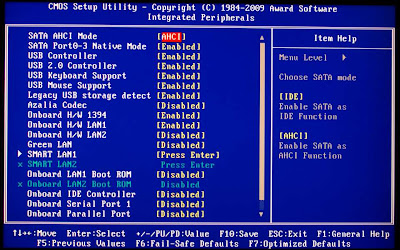Important: To bring up Mac OS X 10.6 on your PC, I do recommend to not use any PCI/PCI-E expansion cards in the first step. Disable all the not needed onboard hardware, like Sound, UART, LPT, IDE, Floppy. Do not connect any special hardware to the USB or Firewire ports. Use only a USB mouse and a USB keyboard. If you have Mac OS X 10.6 up and running, then try to bring up all the other hardware step by step.
Do not overclock your system and take care of the DRAM voltage. My DRAM runs at 1066Mhz and according to the datasheet it needs 2,2V at that speed. But the BIOS only used 1,8V automatically, which gaves me a lot of kernel panics. I got a stable system only after I had changed the DRAM voltage manually to 2,1V.
Enter MB Intelligent Tweaker to verify the BIOS defaults and to set DRAM speed and voltage:
Enter "Advanced BIOS Features" to setup the boot priority & order:
Enter "Integrated Peripherals" to enable SATA AHCI and disable Sound, SMART LAN, IDE, UART and LPT. You can also disable the second LAN port if you don't need it.
















Keine Kommentare:
Kommentar veröffentlichen